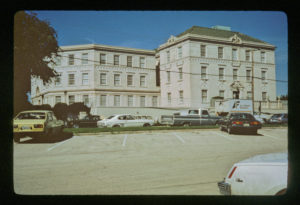 1212 W Lancaster Avenue [NR], WI. Cook Memorial Hospital/W.I. Cook Children’s Hospital/Health South Rehabilitation, 1927-29; 1957-58; 1989-90. The W.I. Cook Hospital was completed in 1929, acclaimed as one of the finest hospitals of its size in the country. The facility was built with and endowed by funds given by Mrs. W.I. (Matilda M.) Cook in memory of her husband and daughter. The hospital offered services without regard for a patient’s ability to pay, and it was Mrs. Cook’s intent that persons who might not otherwise have access to health care be treated here. With an additional endowment from cotton merchant, rancher, and oil man Tom B. Owens, the general hospital was converted in 1952 into W.I. Cook Children’s Hospital.
1212 W Lancaster Avenue [NR], WI. Cook Memorial Hospital/W.I. Cook Children’s Hospital/Health South Rehabilitation, 1927-29; 1957-58; 1989-90. The W.I. Cook Hospital was completed in 1929, acclaimed as one of the finest hospitals of its size in the country. The facility was built with and endowed by funds given by Mrs. W.I. (Matilda M.) Cook in memory of her husband and daughter. The hospital offered services without regard for a patient’s ability to pay, and it was Mrs. Cook’s intent that persons who might not otherwise have access to health care be treated here. With an additional endowment from cotton merchant, rancher, and oil man Tom B. Owens, the general hospital was converted in 1952 into W.I. Cook Children’s Hospital.
Set on a beautifully landscaped, terraced hilltop site, the hospital was designed by Wiley G. Clarkson & Co. and built by Harry B. Friedman, the same team that worked on the neighboring Masonic Temple (CBD 75) a few years later. Reportedly, plans for the building were changed three times as Mrs. Cook’s resources increased when new oil wells came in. It is an excellent piece of eclectic design, drawn from Romanesque and Renaissance sources, featuring an ornamental entry and interior cloistered court. Building materials, which are also of the highest quality, include Indiana limestone, Italian travertine, green terra cotta roof tiles, and heavy bronze doors.
New wings, added in 1957-58 to the second and third floors of the hospital, increased its capacity from 55 to 100 beds. Following the 1985 merger of Cook Children’s Hospital with Fort Worth Children’s Hospital and the subsequent construction of a new Cook-Fort Worth Children’s Medical Center complex at 801 Seventh Avenue, the old hospital facility was sold to Health South Rehabilitation Corp. Working with Health South corporate architects, Gresham, Smith & Partners designed a complementary new three-story addition to the north of the main building and restored the old hospital structure. Frymire Co. was the general contractor for the sensitive addition and the restoration project. The W.I.Cook Memorial Hospital appears to be eligible for the National Register because of its architectural excellence, integrity, siting, and historical importance as one of Fort Worth’s early hospitals.
